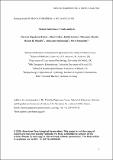Files in this item
Human handedness : a meta-analysis
Item metadata
| dc.contributor.author | Papadatou-Pastou, Marietta | |
| dc.contributor.author | Ntolka, Eleni | |
| dc.contributor.author | Schmitz, Judith | |
| dc.contributor.author | Martin, Maryanne | |
| dc.contributor.author | Munafò, Marcus R. | |
| dc.contributor.author | Ocklenburg, Sebastian | |
| dc.contributor.author | Paracchini, Silvia | |
| dc.date.accessioned | 2020-05-06T15:30:28Z | |
| dc.date.available | 2020-05-06T15:30:28Z | |
| dc.date.issued | 2020-06 | |
| dc.identifier | 267285220 | |
| dc.identifier | ef715d42-ee77-468d-bb89-aa953138b25b | |
| dc.identifier | 000531506900001 | |
| dc.identifier | 85084484273 | |
| dc.identifier.citation | Papadatou-Pastou , M , Ntolka , E , Schmitz , J , Martin , M , Munafò , M R , Ocklenburg , S & Paracchini , S 2020 , ' Human handedness : a meta-analysis ' , Psychological Bulletin , vol. 146 , no. 6 , pp. 481–524 . https://doi.org/10.1037/bul0000229 | en |
| dc.identifier.issn | 0033-2909 | |
| dc.identifier.other | ORCID: /0000-0001-9934-8602/work/71955688 | |
| dc.identifier.uri | https://hdl.handle.net/10023/19889 | |
| dc.description | Silvia Paracchini is a Royal Society University Research Fellow. Judith Schmitz is a DFG fellow and received funding from the School of Medicine, University of St Andrews for this specific work. | en |
| dc.description.abstract | Across time and place, right hand preference has been the norm, but what is the precise prevalence of left- and right-handedness? Frequency of left-handedness has shaped and underpinned different fields of research, from cognitive neuroscience to human evolution, but reliable distributional estimates are still lacking. While hundreds of empirical studies have assessed handedness, a large-scale, comprehensive review of the prevalence of handedness and the factors that moderate it, is currently missing. Here, we report 5 meta-analyses on hand preference for different manual tasks and show that left-handedness prevalence lies between 9.3% (using the most stringent criterion of left-handedness) to 18.1% (using the most lenient criterion of nonright-handedness), with the best overall estimate being 10.6% (10.4% when excluding studies assessing elite athletes’ handedness). Handedness variability depends on (a) study characteristics, namely year of publication and ways to measure and classify handedness, and (b) participant characteristics, namely sex and ancestry. Our analysis identifies the role of moderators that require taking into account in future studies on handedness and hemispheric asymmetries. We argue that the same evolutionary mechanisms should apply across geographical regions to maintain the roughly 1:10 ratio, while cultural factors, such as pressure against left-hand use, moderate the magnitude of the prevalence of left-handedness. Although handedness appears as a straightforward trait, there is no universal agreement on how to assess it. Therefore, we urge researchers to fully report study and participant characteristics as well as the detailed procedure by which handedness was assessed and make raw data publicly available. | |
| dc.format.extent | 44 | |
| dc.format.extent | 5592944 | |
| dc.language.iso | eng | |
| dc.relation.ispartof | Psychological Bulletin | en |
| dc.subject | Handedness | en |
| dc.subject | Meta-analysis | en |
| dc.subject | Laterality | en |
| dc.subject | Hand preference | en |
| dc.subject | Cerebral asymmetries | en |
| dc.subject | BF Psychology | en |
| dc.subject | RC0321 Neuroscience. Biological psychiatry. Neuropsychiatry | en |
| dc.subject | DAS | en |
| dc.subject | BDC | en |
| dc.subject | R2C | en |
| dc.subject.lcc | BF | en |
| dc.subject.lcc | RC0321 | en |
| dc.title | Human handedness : a meta-analysis | en |
| dc.type | Journal article | en |
| dc.contributor.institution | University of St Andrews. School of Medicine | en |
| dc.contributor.institution | University of St Andrews. Centre for Biophotonics | en |
| dc.contributor.institution | University of St Andrews. Biomedical Sciences Research Complex | en |
| dc.contributor.institution | University of St Andrews. Cellular Medicine Division | en |
| dc.identifier.doi | 10.1037/bul0000229 | |
| dc.description.status | Peer reviewed | en |
| dc.identifier.url | https://osf.io/wqf7j/ | en |
This item appears in the following Collection(s)
Items in the St Andrews Research Repository are protected by copyright, with all rights reserved, unless otherwise indicated.

